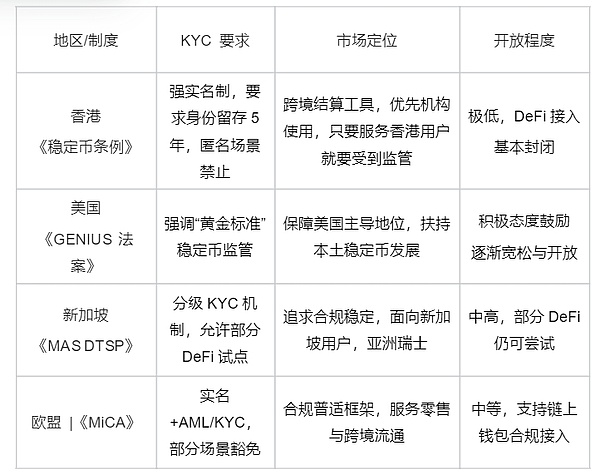
Author: Aki Chen
introduction
On August 1, 2025, the Hong Kong Stablecoin Ordinance officially came into effect. The regulations clearly stipulate that any institution that issues fiat currency anchored stablecoins in Hong Kong or provides local retail sales must apply for a license issued by the HKMA and strictly comply with the requirements of reserve fund mechanism, AML/KYC obligations and openness and transparency.The Hong Kong Monetary Authority also announced the launch of stablecoin license applications. The first round of applications will end on September 30, and the first batch of licenses is expected to be early 2026.This series of actions is regarded by the industry as an important milestone in global stablecoin compliance, but it has also caused fierce controversy between Web3 project parties and the community due to its strong real-name system (KYC) requirements and high threshold exclusive design, which is comparable to the world’s strictest stablecoin bill.At the same time, the US SEC introduced the Project Crypto plan, which proposed not to implement “innovation exemptions” that would be appropriate for overturning things, which is in sharp contrast to Hong Kong.
Overview of the Core Regulations of Stablecoin
According to the new regulations, all acts that issue, circulate, or provide fiat currency anchored stablecoins to local retail users in Hong Kong must obtain an exclusive license issued by the HKMA.Core requirements include:
·Capital requirements: minimum paid-in capital of HK$25 million;
·Reserve mechanism: 100% high-quality liquid asset backing (cash, short-term treasury bonds), custody isolation must be achieved, and remortgage is prohibited;
·Redemption mechanism: Users must be able to redeem at face value within 1 day;
·Real-name system (KYC): All user identities must be retained for more than 5 years, and DeFi scenarios and anonymous wallet access are clearly prohibited;
·Prohibition is prohibited: Unlicensed stablecoins shall not be marketed to the public, and violators may face fines and criminal liability.
Among all regulatory provisions, the KYC real-name verification requirement has become the focus of the biggest controversy in the Web3 community.According to the requirements of the HKMA, stablecoin issuers must not only verify user identity information and retain data records for more than 5 years, but also shall not provide services to anonymous users.Early stageFor every Hong Kong compliant stablecoinHolderIdentity verification is also required.In response, Hong Kong Legislative Council members said that the Hong Kong Monetary Authority will indeed implement the KYC rules, but the specific implementation method is currently uncertain, and the real-name system is one of the solutions.Chen Jinghong, assistant president of the Hong Kong Monetary Authority (regulation and combating money laundering), also pointed out that the arrangement is more stringent than the “whitelist” mechanism proposed in the earlier anti-money laundering consultation documents.However, in the end, he also said that with the gradual maturity of relevant technologies, the possibility of moderate relaxation of regulations cannot be ruled out in the future.

This means that Hong Kong’s stablecoins may not have the ability to directly interact with the DeFi protocol in the early stage, and decentralized wallets and unlicensed addresses will be isolated from the compliance system, and such interactions will also be legally considered “unauthorized use”.It can be seen that compared with the scalability and freedom of on-chain protocols, Hong Kong regulators focus more on controlling the regulatory power of stablecoin circulation.This move and attitude are also regarded by some businesses as pouring cold water on the application of stablecoins to open financial scenarios on the chain.There is a huge difference with the existing mainstream stablecoins (such as USDT, USDC) that allow free transfer between wallets and seamless connection with DeFi protocols, which will inevitably have an impact on user experience and popularity.

To make matters worse, according to the provisions of the Hong Kong Monetary Authority’s Stable Coin Issuer Regulatory Framework, when “offering a specified stablecoin”, the licensee must comply with the laws and regulatory requirements of the relevant jurisdictions.This provision emphasizes that not only ensure compliance with issuance, but also a complete set of institutional guarantee mechanisms covering cross-border operations, identifying restricted areas, and proactive blockades are needed.
Specifically, it includes the following three obligations:
1. Prohibited services to specific areas
Licensors must ensure that they do not conduct issuance or offer in jurisdictions where stablecoins are prohibited.Regulatory recommendations are implemented through multi-dimensional means, including: verifying user identity documents (such as ID cards or passports) to identify nationality or place of residence; judging the user’s real geographical location through IP addresses or GPS location technology; technical blocking of access from restricted areas to prevent downloading, registration or purchase behaviors.This requirement essentially requires licensees to play the role of a “geographic risk firewall” to cut off potential access paths to restricted areas from the source of issuance to prevent violations of other countries’ laws or trigger cross-border regulatory disputes.

3.5.3It also clearly states that the licensee needs to detect whether the user uses a virtual private network to determine whether the user uses a virtual private network, that is, if you do not allow stablecoins to be used, even if you use a virtual private network, it is a violation.This significantly increases the user threshold, and every user needs to submit identity certificates. The process is cumbersome, erasing the experience of “opening a wallet” is eliminated.At the same time, it may make it difficult for global users to access. If non-Hong Kong local users are not clearly included in the policy scope, they may not be able to use stablecoins issued by Hong Kong in practice.Transfers are also strictly restricted. Stablecoin licensees will be regarded as financial institutions and need to comply with the relevant requirements of the FATF on fund transfer rules. Before transferring, you need to ensure that both the recipient and the initiator have completed the KYC and accompanied by relevant information, otherwise the platform or contract may prevent transaction execution.
This requirement of Hong Kong’s regulation is essentially transforming “stable coins” into electronic certificates in the form of controlled circulation of electronic currencies or bank tokens. It is characterized by no longer a common decentralized asset on the chain, but a digital tool with real-name binding, geographical restrictions, and regulatory attributes.
2.Overseas marketing and operations must be fully compliant
In addition to the jurisdiction blockade obligations that prohibit transactions, the provisions also require licensees to ensure that all business operations and marketing activities (such as advertising promotion, cooperation channels, application deployment, etc.) comply with applicable regulations of the target market.This means:
·Marketing content shall not be pushed to unlicensed areas;
·It should be evaluated whether overseas partners have compliance qualifications;
·The website language version, terms of service, etc. should be handled with caution to avoid legal facts that constitute “actually providing services”.
3. Continuous monitoring and dynamic adjustment mechanism
Regulation further requires licensees to establish a continuous monitoring mechanism, closely monitor policy changes in various countries/regions, and timely adjust their business strategies and technical measures.For example: If a country adds a new stablecoin ban, the issuer should immediately terminate the relevant services; if regulatory standards are improved (if additional licensing or real-name requirements are required), the KYC process and compliance review system should be updated simultaneously.
In this regard, Dr. Xiao Feng, chairman and CEO of HashKey Group, once said that in the traditional financial field, anti-money laundering mechanisms rely highly on identity-based information retrieval and account information, but in actual operations, this system faces serious bottlenecks in scenarios of multiple banks, multiple regions, and cross judicial boundaries.In contrast, the on-chain tracking and address labeling mechanism developed by the Crypto industry in recent years provides another idea for anti-money laundering.In the blockchain system, each transfer is open and transparent, and the historical capital flow trajectory of any address can be traced throughout the process.From token minting, first circulation, cross-chain transfer to final attribution, on-chain information is tampered with, globally readable, and real-time synchronization, improving the efficiency and accuracy of money laundering path recognition.
Industry impact analysis: project party, user and market chain reaction
According to a field investigation by Techub News reporters, on the first day when the Hong Kong Stablecoin Ordinance officially came into effect on August 1, some cryptocurrency OTC offline stores, including One Satoshi, have temporarily closed down due to concerns that they violate the regulatory red line.At the same time, several OTC stores have chosen to continue to operate normally, and the industry has different understandings of the scope of application of the new regulations.After the ordinance was introduced, the responses of the Hong Kong Web3 industry were different.Some say “There is finally supervision”, but others say “this is not the kind of supervision we want.”Real-name system, licensing system, high thresholds, and restrictions one by one, keeping many native projects out of the door.In particular, stablecoins cannot be directly connected to DeFi, and anonymous wallets and open contracts are excluded from compliance, which basically means a clear statement: Hong Kong stablecoins will not support free circulation on the chain.
This is obviously a blow to some teams who originally wanted to regard Hong Kong as a Web3 base.If you want to issue coins, you have to apply for a license; if you want to make a wallet, you have to make sure that each address has a real name — —This deviates from the traditional sense of “Web3”, and is more like “Web2.5”, or “licensed chain finance.”The more realistic problem is that the ordinance excludes some small and medium-sized entrepreneurs. Although the Hong Kong Monetary Authority welcomes innovation, it seems that banks and giants are more welcome. Only invited institutions or platforms are eligible to apply for licenses.The entire institutional design is more like allowing “orthodox forces” to dominate the development of stablecoins, and individuals and small projects either wait and see or leave.If the Hong Kong Web3 ecosystem was growing wildly in the past, it is now a complete “order reshaping”.However, in the pursuit of compliance and financial stability, Hong Kong may also lose the free temperament that initially attracted developers.
Comparison with regulatory frameworks in other regions
Compared with the “innovation exemption” proposed by the Project Crypto plan just issued across the ocean, the new Hong Kong stablecoin regulations are mainly characterized by clear supervision, strong KYC real-name system, and strong anti-money laundering.

It can be seen that Hong Kong’s current strategy is more inclined to build “quasi-sovereign settlement tools”, emphasizing regulatory dominance and financial security, and blocking core capabilities such as typical permissionless structures, contract calls, and decentralized wallets in Web3 outside the regulatory system.This presupposes to some extent that stablecoins “can only serve regulated financial institutions” rather than being used as neutral infrastructure for on-chain ecosystems.
In contrast, although the EU MiCA also emphasizes KYC, it allows for certain flexibility — — —For example, there are exemptions for low-value transactions or allow anonymous wallets; while Singapore DTSP is closer to the “layered sandbox” idea, and welcomes DeFi projects with risk control capabilities to gradually test the waters.In the United States, although supervision has been lagging behind for a long time, after the signing of the GENIUS Act, the release of the PWG report, and the launch of the Project Crypto program, there has been a strong signal to shift to on-chain system modernization and take into account financial innovation.The current SEC chairman emphasized in his public speech: “We introduce supervision for the sake of supervision and implement the matter of undermining the situation.”
This comparison reveals the core differences: Hong Kong bets on stablecoin compliance infrastructure, the United States moves to on-chain institutional modernization, the EU seeks universal standards, and Singapore maintains openness of financial experiments.Hong Kong’s current route is more suitable for “licensed chain finance” that serves offshore settlement, but for Web3 paths that focus on open ecology and anonymous circulation, its compatibility and attractiveness are relatively limited.
Conclusion: Whether compliance and opening up can balance, Hong Kong is still testing the boundaries
Supervision must move forward, but there should be blank space.As an Asian financial center, Hong Kong is not only a experimental field of technology and systems, but also a responsibility to establish a paradigm for the region and even the world.However, while promoting KYC’s real-name, anti-money laundering and traceability mechanisms, how to not completely erase the privacy space on the chain and how to retain a certain degree of openness and scalability while ensuring financial security is the real long-term challenge of this bill.As Dr. Xiao Feng said, the most fundamental feature of blockchain can develop without permission.Anyone can freely join or exit the Internet. The real-name system and approval mechanism emphasized by the Hong Kong stablecoin supervision deviates in a sense from this open logic without permission.
Stablecoins are essentially an institutional innovation tool that connects on-chain and off-chain, connecting traditions and the future.If there is excessive “paternal” supervision, it will not only be difficult to integrate into the current DeFi ecosystem, but it may also lose Hong Kong’s key position in the reshaping of the global digital financial order.In the next stage of implementation and explanation, how Hong Kong can find a balance between regulatory rigidity and technical flexibility deserves continuous attention from all walks of life.






